It’s the early part of the 19th century. Napoleon is trying to conquer Europe. England is trying to stop him. And everybody needs gunpowder.
Turns out there’s no such thing as a gunpowder mine (thank heavens for small mercies), so the stuff had to be manufactured. And one of the waste products of this process was giant piles of violet-colored solids.
A French chemist, Bernard Courtois, whose father was a saltpeter manufacturer, was the first to suspect that this violet stuff was an as-yet-undiscovered chemical element. When this discovery was confirmed, the new element was named iodine, after the Greek word for violet: ioeidēs.
It’s a pretty rare element in the universe and on Earth (which I’m guessing is where most of my readers live), with the greatest concentrations found in the oceans. But it’s crucial for the health of all vertebrates because it’s necessary for the functioning of the gland responsible for energy production: the thyroid.
Iodine deficiency is less of a problem these days because of global public health campaigns to add the nutrient to table salt (that’s what “iodized” means on the label), but it still affects up to 30% of the world’s human population.
If you consume iodized salt, you’re almost certainly getting enough iodine. But a lot of salt sold in natural foods stores, such as Himayalan and Celtic sea salt, only contains trace amounts of naturally occurring iodine — if any. And if you choose to avoid added sodium as part of an “SOS-free” diet (that is, free of added salt, oil, and sugar), you may want to consider getting your iodine from other sources.
The thing is, though, that both too much and too little iodine can be problematic. So how much iodine do you need? What are the best sources? And how can you avoid excess or deficiency?
What Is Iodine?
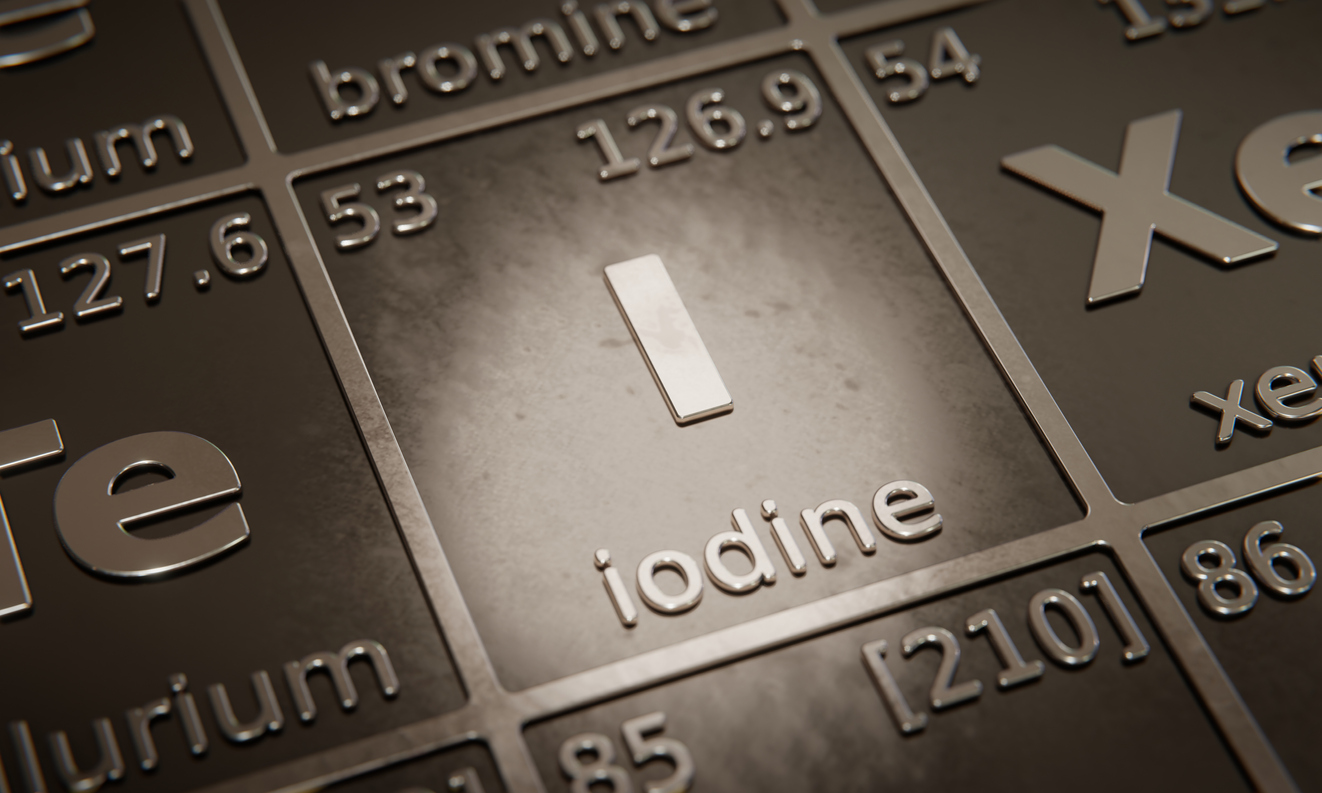
Iodine is an essential micronutrient that’s necessary for human health. Even though you only need a small amount, you do need iodine from food or supplements because the body doesn’t make its own.
The thyroid gland, a small, butterfly-shaped organ located in the front of the neck, needs iodine to produce the hormones thyroxine (T4) and triiodothyronine (T3), which play several critical roles in your body.
T4 and T3 are important for metabolism, the body’s process of turning food into energy. They help maintain the body’s temperature, heart rate, and energy levels. They’re also necessary for proper bone and brain development during pregnancy and infancy.
Iodine can be the limiting factor in the thyroid’s hormone factory. When you don’t get enough iodine, your thyroid can become underactive, a condition known as hypothyroidism. At the same time, too much iodine can cause the thyroid gland to go into overdrive, a condition called hyperthyroidism. We’ll look at both of these conditions in more detail below.
If you find yourself getting confused about hypo- and hyperthyroidism, here’s a quick Greek lesson. “Hypo” means “too little” or “under.” For example, hypothermia means “too little heat,” and a hypodermic needle injects “under the skin.” “Hyper,” on the other hand, means “too much.” For instance, hyperactivity describes overly active behavior, and a “hyperbole” is an exaggeration.
How Much Iodine Do You Need?
Iodine is known as a “trace” mineral since you need only a small amount. The US Recommended Daily Allowances (RDAs) are considered the “floor” — the minimum quantity needed for health. You might think that more is better, but as I mentioned earlier, it’s also easy to get too much. You want just the right amount. (Think “Goldilocks” — although now that I do, what’s the deal with Papa Bear’s porridge being too hot and Mama Bear’s being too cold? How does that happen?)
Here are the iodine RDAs:
| Age | RDA(mcg/day) | Pregnancy(mcg/day) | Lactation(mcg/day) |
| Birth to 6 months | 110 | ||
| 7–12 months | 130 | ||
| 1–3 years | 90 | ||
| 4–8 years | 90 | ||
| 9–13 years | 120 | ||
| 14+ years | 150 | 220 | 290 |
That “mcg” is short for microgram, which is one-millionth of a gram. If you picture cutting a single paperclip (regular size, not a “jumbo” one) into a million pieces, each of those pieces would weigh roughly one microgram. (Fun fact: If each cut took five seconds, you would need nearly two months of nonstop snipping to get the job done.)
Iodine Deficiency
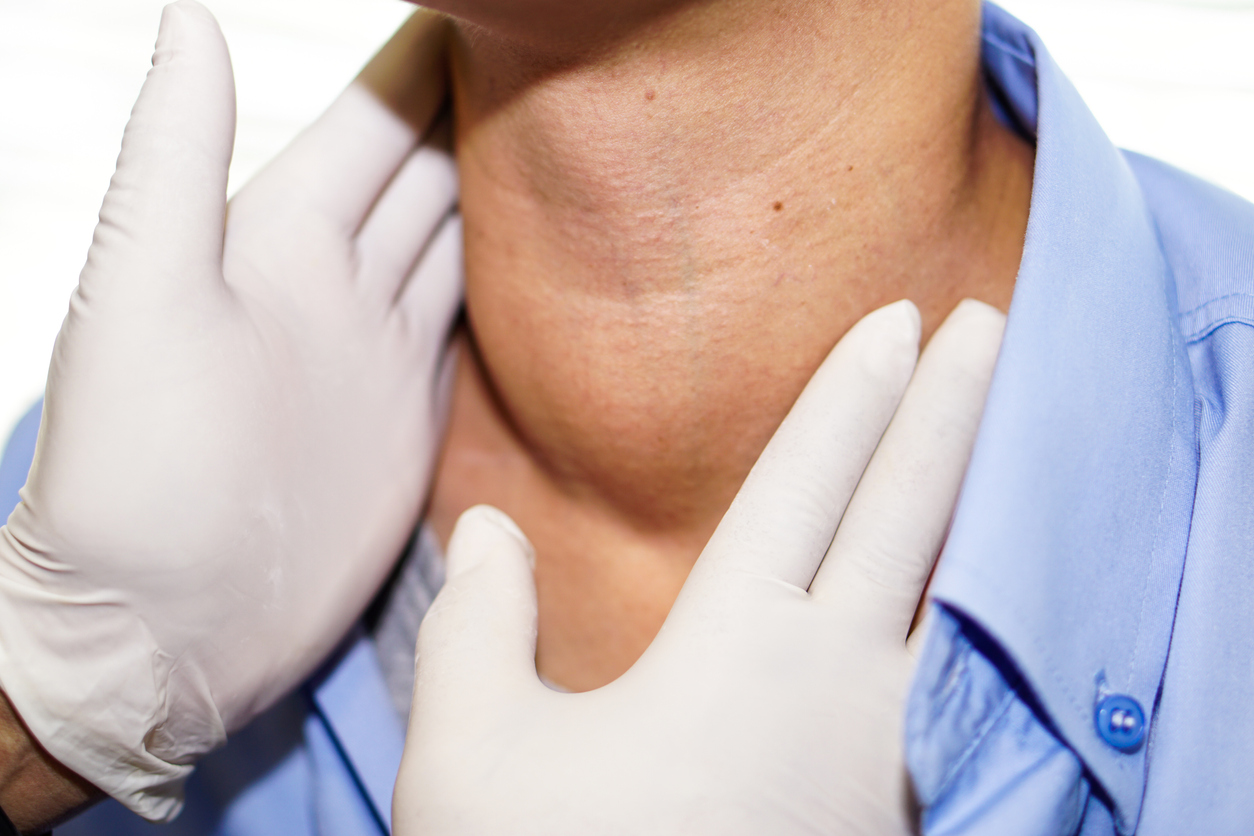
As we’ve seen, not getting enough iodine in the diet results in iodine deficiency, which can cause iodine deficiency disorders (IDDs). One of these is goiter, or an enlargement of the thyroid. When your pituitary gland notices a shortage of thyroid hormones, it sends a message to the thyroid to increase production. The thyroid gland tries to compensate by increasing its activity.
In the absence of sufficient iodine, however, this increased activity, instead of bringing the hormones to their proper levels, causes an enlarged thyroid that can make it difficult to swallow, cough, and even breathe.
Even without goiter, not enough iodine can cause the thyroid gland to be underactive, a condition known as hypothyroidism. In this condition, the body’s iodine levels decrease, keeping your thyroid from producing enough thyroid hormones. Your metabolism slows, and accompanying symptoms can include fatigue, weight gain, cold intolerance, infertility, and depression.
Prior to the 1920s, iodine deficiency was prevalent in the Great Lakes, Appalachians, and Northwestern regions of the US, an area that came to be known as the “goiter belt.” A survey conducted in Michigan in 1923 found that in some regions, around 60% of the population suffered from goiters, including children.
This finding led to a concerted public health campaign to add iodine to the food supply. The campaigners hit upon salt as the simplest, most effective delivery mechanism for the mineral.
The implementation of these salt-iodization programs worldwide has reduced the incidence of iodine deficiency, but 30% of the world’s population is still at risk. Mild to moderate iodine deficiency not only remains common but appears to be increasing, especially during pregnancy, when needs are the highest.
In pregnancy, iodine deficiency is defined as an iodine level in the urine of less than 150 mcg/L. In those who are not pregnant, it’s less than 100 mcg/L of urine.
Iodine Excess
So if not enough iodine is a problem, then surely the solution is to consume lots of it, right? Well, not so fast. Too much iodine can also cause problems. Ironically, many of the symptoms of excess iodine are the same as those of deficiency, such as goiter, elevated TSH levels, and hypothyroidism.
And if too much iodine is administered to treat iodine deficiency, that can lead to hyperthyroidism, or overactive thyroid. Basically, your body’s metabolism goes into overdrive, producing symptoms such as nervousness and anxiety, mood swings, difficulty sleeping, frequent urination, persistent thirst, muscle weakness, fatigue, and sensitivity to heat.
Too much iodine intake can cause thyroiditis (inflammation of the thyroid; the Greek suffix “itis” means inflammation) and even thyroid papillary cancer, which is the most common form of thyroid cancer.
Acute iodine poisoning is rare because few foods have enough iodine to cause it, but it is possible through excess supplementation. Symptoms include burning of the mouth, throat, and stomach, fever, abdominal pain, and even coma.
To avoid iodine poisoning when taking supplemental iodine, the US Food and Nutrition Board has identified the following safe Upper Limits (ULs) for the mineral:
- 1–3 years: 200 mcg
- 4–8 years: 300 mcg
- 9–13 years: 600 mcg
- 14–18 years: 900 mcg
- 19+ years: 1,100 mcg
If you are iodine deficient or have a preexisting thyroid condition, those ULs might be too high, as you may be extra sensitive to iodine intake levels considered safe for the general population. Additionally, infants, the elderly, and pregnant and lactating women may also be more susceptible to excess iodine.
Considerations for Thyroid Disease
While iodine deficiency or excess can contribute to thyroid dysfunction, it’s important to approach iodine supplementation cautiously if you have an autoimmune thyroid disorder like Hashimoto’s thyroiditis or Grave’s disease. The thyroid gland is more sensitive in these autoimmune conditions and can be aggravated by excessive iodine intake, potentially worsening inflammation and thyroid function.
For people with Hashimoto’s and Grave’s disease, focusing on a balanced diet that includes iodine from natural sources and ensuring adequate selenium intake can support thyroid health without exacerbating autoimmune responses. And of course, personalized guidance from a healthcare provider knowledgeable about both nutrition and autoimmune conditions can be essential to optimize thyroid function and overall wellness.
Iodine Sources
So, where can you get this extremely important nutrient in concentrations that would make Goldilocks skip with joy? Let’s start with food.
Iodine in Food
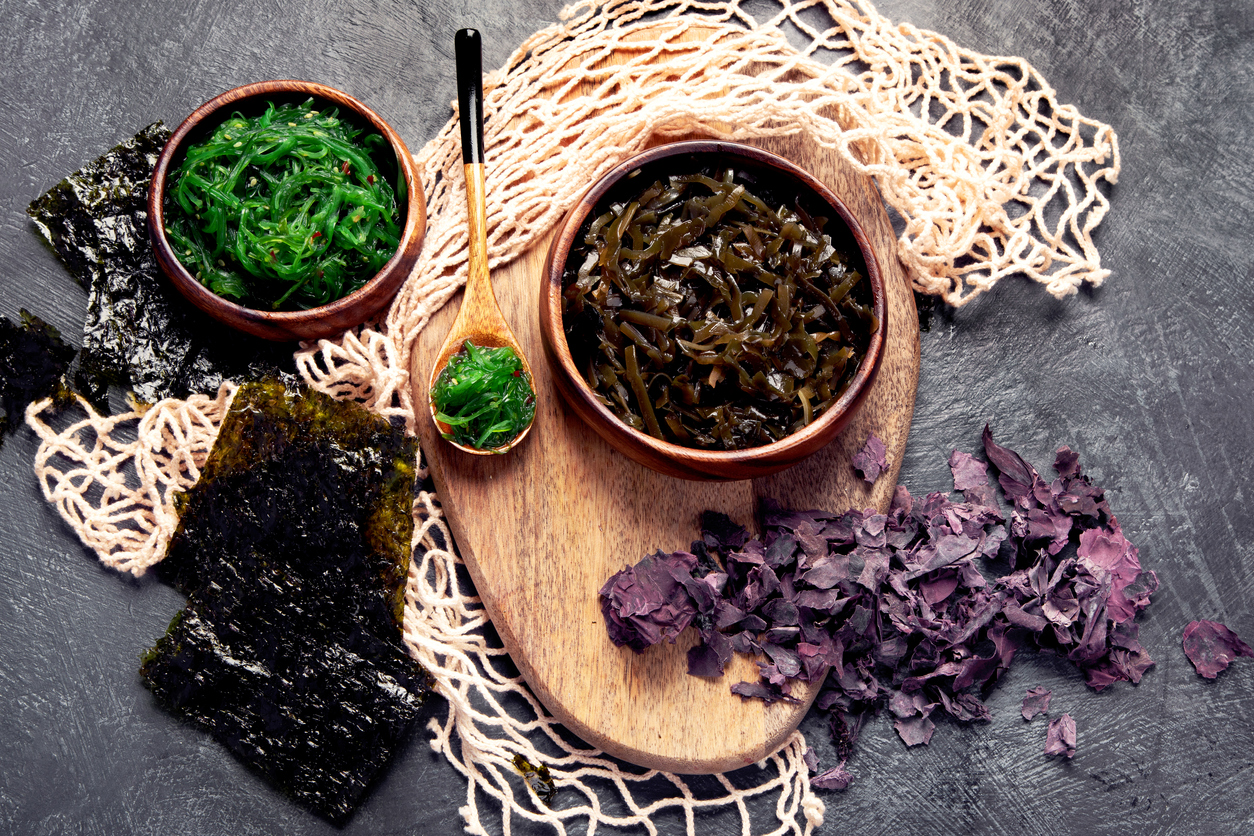
Since iodine is mostly found in seawater (a single cup delivers about 12.5 mcg), it makes sense that foods that grow in the sea would be rich sources. And indeed, sea vegetables (aka seaweed) are among the best food sources of iodine.
However, different types of sea vegetables have wildly variable levels of iodine. Those with safe levels include wakame, nori, arame, and dulse. You can think of these as plant-based iodine supplements.
Here are some ways to get your daily allowance of iodine from these sources: Snack on a couple of nori sheets during the day (or use them for rolling homemade sushi); sprinkle a teaspoon of dulse flakes into savory dishes like salads, soups, and stews; add a teaspoon of dried arame to soups for umami awesomeness; or use two teaspoons of ground dried wakame as a salad topper.
Other forms of seaweed are so rich in iodine, you actually have to be careful not to overconsume them and risk hyperthyroidism. In fact, some species of kelp (such as kombu) are generally not recommended because their iodine content is so high.
Most people may want to stay below an average of 300 mcg/day on a day-to-day basis, and definitely below 1,100 mcg/day (that daily tolerable upper limit for people without thyroid disease). Since a single tablespoon of dried kelp may contain up to 2,000 mcg of iodine, even modest amounts of this sea vegetable on a regular basis could cause problems.
On the bright side, at least if you’re like Baby Bear and want to mitigate the risk of getting too much, cooking significantly reduces the amount of iodine you get from sea vegetables. For example, boiling kombu for 15 minutes can make it lose up to 99% of its iodine content. Much of that iodine may be released into the water, however. So if you’re cooking sea vegetables and then drinking their broth, you could still be getting a hefty dose of iodine.
Iodine is also found in fish and other seafood (who get it from the same place as sea vegetables get it), and also in meat, eggs, and dairy products. If you refrain from eating animal products, your options are pretty much limited to iodized salt, sea vegetables, or supplementation.
Iodine is found in small amounts in a variety of fruits and vegetables, including prunes, cranberries, and strawberries. The trouble is, terrestrial plants are very hit-or-miss, with their iodine content dependent on the mineral’s concentration in soil, groundwater, and fertilizer.
Some breads are also enriched with iodine in the form of a dough conditioner, but because it’s only around 20% of breads, specifically white bread, this is neither a reliable nor healthy source of iodine. You can also boil noodles in water with iodized salt; the noodles will absorb some of the iodine, even if you rinse them off after cooking.
Iodized Salt
For most people, iodized salt is the best iodine source. The two forms of iodine used for this purpose are cuprous iodide (bonded with copper) and potassium iodide. Iodized salt in the US is fortified at 45 milligrams of iodide per kilogram.
Globally, approximately 120 countries, including Canada and some parts of Mexico, have mandated iodization of all food-grade salt. In the US, however, iodization is voluntary, and the FDA doesn’t make manufacturers list the iodine content on nutrition facts labels.
There’s reason to believe that the proportion of US households that use only iodized salt has remained stable at 70–76% since the 1950s. But there’s also reason to think that consumption of iodized salt has decreased in the diets of many Americans, for a few reasons.
First, the majority of salt consumption in the US comes from processed foods, which typically use non-iodized salt. Second, many people have been advised by their doctors to reduce their sodium intake to manage or prevent certain health conditions, such as hypertension and kidney disease. And third, a small but growing number of people have started using Celtic salt, Himalayan salt, and other varieties that contain no added iodine.
Nevertheless, iodized salt is still the top-recommended strategy for the prevention of thyroid disorders.
Iodine Supplements

After food and salt, the third way to get iodine is by taking a supplement, typically in the form of potassium iodide. Multivitamin and mineral supplements may contain iodine, often at a dose of 150 mcg. And prenatal supplements may also contain iodine. You can also find dietary supplements containing only iodine. However, these may deliver high doses, sometimes above the UL.
Iodine supplementation is recommended for people who are pregnant and breastfeeding. The American Thyroid Association and the Endocrine Society advocate for prenatal supplements that provide a daily dose of 150 mcg potassium iodide (which translates into 114 mcg iodine); these supplements are necessary throughout pregnancy and lactation.
Plant-based eaters may also want to supplement if they’re not eating sea vegetables or using iodized table salt regularly. And people with iodine-deficient hypothyroidism may want to discuss supplementation with their health care providers.
If you opt for getting enough iodine through your diet (whether through food itself or iodized salt), we’ve created three iodine-rich recipes that are easy to make and a delight to enjoy. Plus, thanks to the customization of each recipe, you can keep iodine-rich meals in your weekly meal prep rotation with ease!
1. Vegetable Hand Rolls
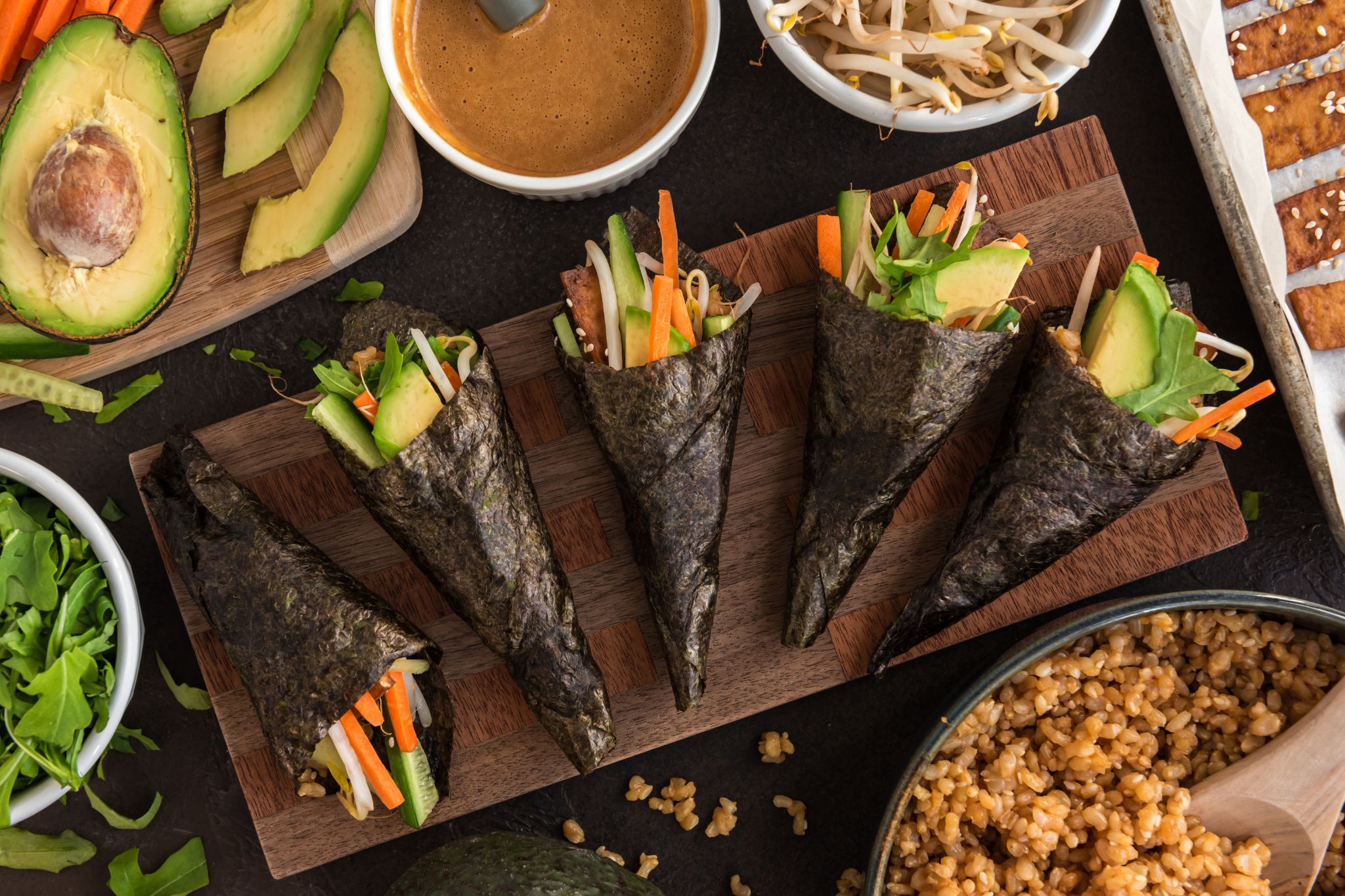
If you’re plant-based and you want to avoid adding iodized salt to meals then your top source is sea vegetables — enter Vegetable Hand Rolls! These rolls are fun to make because anything goes. Use veggies from your fridge or your garden. The only requirement is that they fit into the roll. Top with your favorite sauce, and voilà — your taste buds, belly, and thyroid will all be very happy.
2. Sea Veggie Gomasio
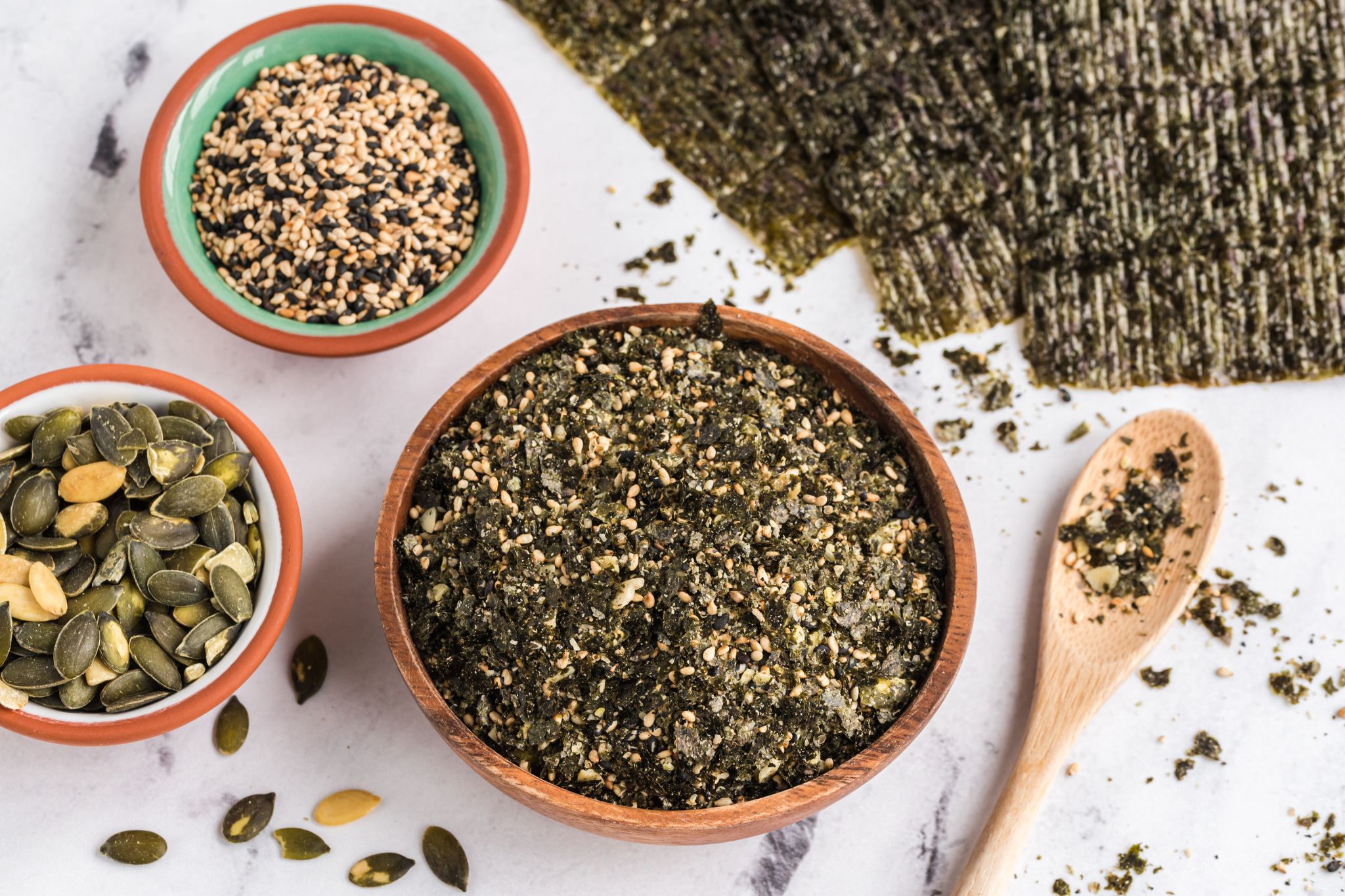
Keeping a jar of Sea Veggie Gomasio on hand can be an easy way to make sure you are incorporating iodine (and other essential nutrients) into your diet regularly. Nori is not only rich in iodine, it has all nine essential amino acids, plus omega-3s and calcium to boot! Sesame seeds also contain healthy fats, calcium, and magnesium. And pumpkin seeds are a good source of protein, vitamin K, and zinc. Add this condiment to grain bowls, soups, salads, and avocado toast to support a healthy thyroid and more!
3. Warm Arame Kale and Rice
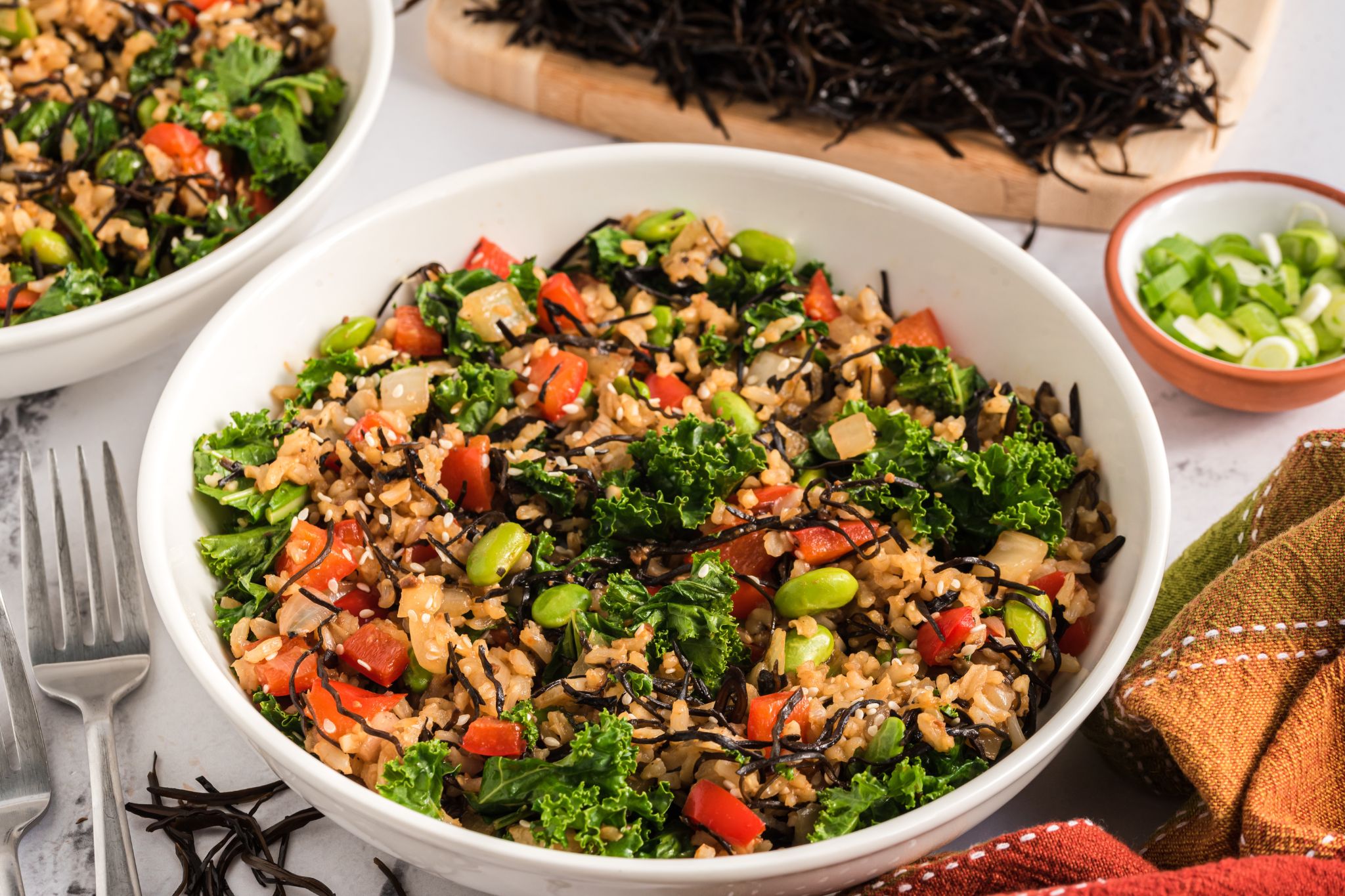
This tasty dish is teeming with minerals like calcium from the kale, edamame, and sesame seeds; iodine from the arame; and iron from the rice — three nutrients that can sometimes fall short in a plant-based diet. Lucky for you, Warm Arame Kale and Rice is easy to make, can be served as a side to tofu or tempeh, and easily shines as the star of the show!
Iodine Is Important for Health
Iodine is an essential trace mineral necessary for good thyroid health. Most people can avoid iodine deficiency through diet alone, especially if they use iodized salt or eat sea vegetables. And since excess iodine can also be problematic, caution is suggested in the consumption of kombu and iodine-only supplements. That said, pregnant and lactating individuals may want to consider supplementation, along with people with certain thyroid conditions. Overall, getting the right amount of iodine is important for everyone.
Tell us in the comments:
- Where do you get your iodine?
- Have you tried adding sea vegetables to your diet? What’s your favorite way to consume them?
- Which iodine-containing recipe will you try next?
Featured Image: iStock.com/simarik

